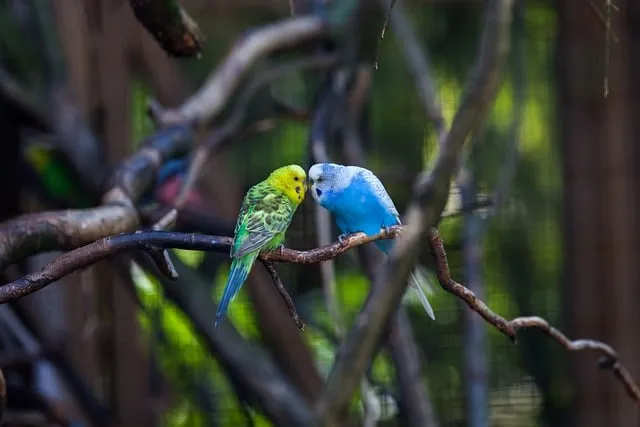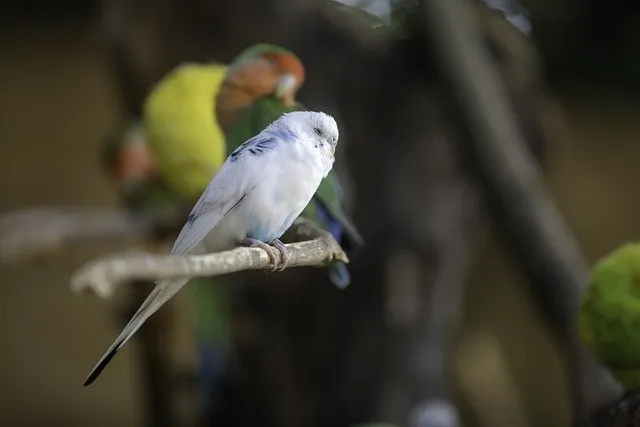As an Amazon Associate I earn from qualifying purchases.
Unlock the door to a vibrant world of avian culinary artistry as we embark on a feathered adventure into the intriguing question: “What do lovebirds eat?” This comprehensive guide will dive deep into lovebird nutrition, exploring their favorite foods, the importance of a balanced diet, and how to keep your beloved pets healthy and content through their daily meals. Whether you’re a novice bird enthusiast or an experienced avian caretaker, you’ll find valuable insights here to ensure your lovebirds thrive on a nutritious and delectable diet. So, let’s embark on this journey to discover the culinary delights that will make your lovebirds chirp with joy!
What Do Lovebirds Eat?
Lovebirds, with their colorful plumage and affectionate personalities, are cherished companions for bird enthusiasts worldwide. When it comes to ensuring their well-being, nothing is as crucial as their diet. So, what do lovebirds eat, and how can you provide them with a balanced, nutritious meal plan? In this comprehensive guide, we’ll explore the dietary needs of lovebirds and explain the importance of each type of food in their diet.
1. Seeds: A Staple in Lovebird Diets
Seeds are a fundamental component of a lovebird’s diet, providing essential fats, vitamins, and minerals. Lovebirds have a particular fondness for various seeds, including sunflower, millet, and safflower seeds. A well-balanced seed mix is vital to prevent nutritional deficiencies.
2. Pellets: A Balanced Diet Option
Pellets offer a convenient way to supply a well-rounded diet to your lovebirds. These specially formulated pellets contain a blend of seeds, grains, fruits, and vegetables, meeting your lovebird’s nutritional requirements in one package. Seek high-quality, species-specific pellets to ensure optimal nutrition.
3. Fresh Fruits and Vegetables: A Splash of Color and Nutrients
Variety is key to fresh fruits and vegetables in your lovebird’s diet. These foods supply essential vitamins and minerals while adding diversity to their meals. Some favored choices include apples, carrots, and broccoli. Always wash fruits and vegetables thoroughly to eliminate any potential pesticides or contaminants that might harm your feathered friend.
4. Protein: Essential for Optimal Health
Protein is vital, especially during breeding seasons. Protein sources include hard-boiled eggs and cooked legumes like lentils, chickpeas, and beans. Ensure legumes are well-cooked to make them safe for your lovebird to consume.
5. Nuts: Occasional Delights
Nuts are high in fat and should be given sparingly as treats. Lovebirds might savor small pieces of almonds, walnuts, or pecans. Reserve these treats for training sessions or as an occasional snack.
6. Clean Water: The Unsung Hero
Lastly, don’t forget the importance of clean, fresh water in your lovebird’s diet. Provide a source of clean water in a suitable container and change it daily to prevent contamination.
What Predator Does Lovebird Have?
In their natural habitat in Africa, lovebirds face several potential predators that can threaten their survival. These predators have evolved to target birds as a food source, and lovebirds, despite their small size and vibrant colors, are not exempt from predation pressures. Here are some of the key predators that lovebirds may encounter:
1. Birds of Prey:
Raptors such as hawks, eagles, and falcons are formidable predators that significantly threaten lovebirds. These birds have sharp nails, powerful beaks, and excellent eyesight, making them efficient hunters of small birds like lovebirds. Raptors often hunt from the air and can swoop down on lovebirds in flight or while they are perched.
2. Snakes:
Certain snake species are known to prey on birds, including lovebirds. Snakes are stealthy hunters who can access nests, tree hollows, or roosting spots to consume eggs, chicks, or even adult lovebirds if they can get to them.
3. Mammals:
Various small to medium-sized mammals can be potential threats to lovebirds. This includes creatures like mongooses, squirrels, and rodents. They may raid nests to consume eggs and young birds. These mammals are often opportunistic and can pose a particular risk to lovebird chicks still in the nest.
4. Other Birds:
Some larger bird species, although not their primary diet, may raid lovebird nests for eggs or chicks. Common examples include crows, magpies, and starlings. These birds are known to engage in nest predation, potentially jeopardizing lovebird breeding success.
5. Humans:
While not natural predators in the traditional sense, humans have significantly impacted lovebird populations. Habitat destruction due to deforestation, urbanization, and agricultural expansion has led to the decline of many lovebird species. Also, lovebirds are often captured for the pet trade, which can negatively affect wild populations.
How Can Lovebirds Help Our Ecosystem?
While primarily known for their popularity as pets, lovebirds can also play a role in their natural ecosystems. Here’s a detailed explanation of how lovebirds can contribute to their ecosystems:
1. Seed Dispersal:
Lovebirds are frugivorous; they eat fruits and play a vital role in seed dispersal. When lovebirds consume fruits, they often swallow the seeds and the pulp. These seeds are later excreted in different locations, helping to spread plant species. This process is crucial for plants’ regeneration and genetic diversity, contributing to ecosystems’ overall health and biodiversity.
2. Pollination:
Like many other bird species, lovebirds may inadvertently aid in pollination as they feed on nectar-producing flowers. While they primarily seek nectar for sustenance, their visits to flowers can transfer pollen from one bloom to another, facilitating the reproduction of flowering plants. This is especially relevant in their native African habitats, where they interact with various plant species.
3. Prey for Predators:
Lovebirds are part of the food web in their ecosystems. They serve as a food source for various predators, including birds of prey, snakes, and mammals. By being part of the diet of these predators, lovebirds contribute to the energy flow and balance of their ecosystems.
4. Competition for Nest Sites:
Lovebirds often compete with other cavity-nesting birds, such as parakeets and woodpeckers, for suitable nesting sites in tree hollows. This competition can have ecological significance by influencing nest site availability for other bird species. In some cases, lovebirds may excavate their nesting cavities, creating new opportunities for cavity-nesting birds.
5. Ecosystem Indicator:
The presence or absence of lovebirds in an ecosystem can serve as an indicator of its health. A thriving population of lovebirds suggests the availability of food resources and suitable nesting sites. Their decline or disappearance may indicate environmental changes or habitat degradation that require attention and conservation efforts.
Final Words
In wrapping up our exploration of lovebirds and their ecological significance, we’ve delved into the fascinating world of these colorful avian companions. Beyond the enchanting question, “What do lovebirds eat?” We’ve uncovered their hidden role in nature. While adored as pets, these feathered wonders contribute to their ecosystems through seed dispersal, potential pollination, and interactions with predators and nesting competitors. So, the next time you marvel at the charm of lovebirds in your home, remember that their impact extends far beyond our hearts, enriching the delicate tapestry of the natural world.
You can also read:
1.What Do House Wrens Eat? Insectivores of the Garden
2.What Do Hippopotamuses Eat? Dining with Giants
3.What Do German Shepherds Eat? Feeding Your Furry Guardian
4.What Do Clouded Leopards Eat? Unlocking the Mystery of the Wild
Amazon and the Amazon logo are trademarks of Amazon.com, Inc, or its affiliates.



